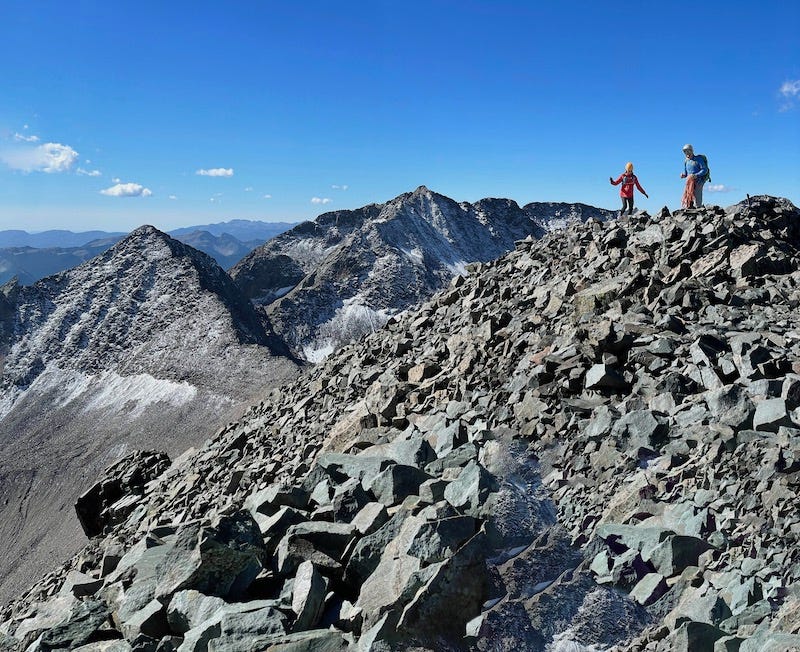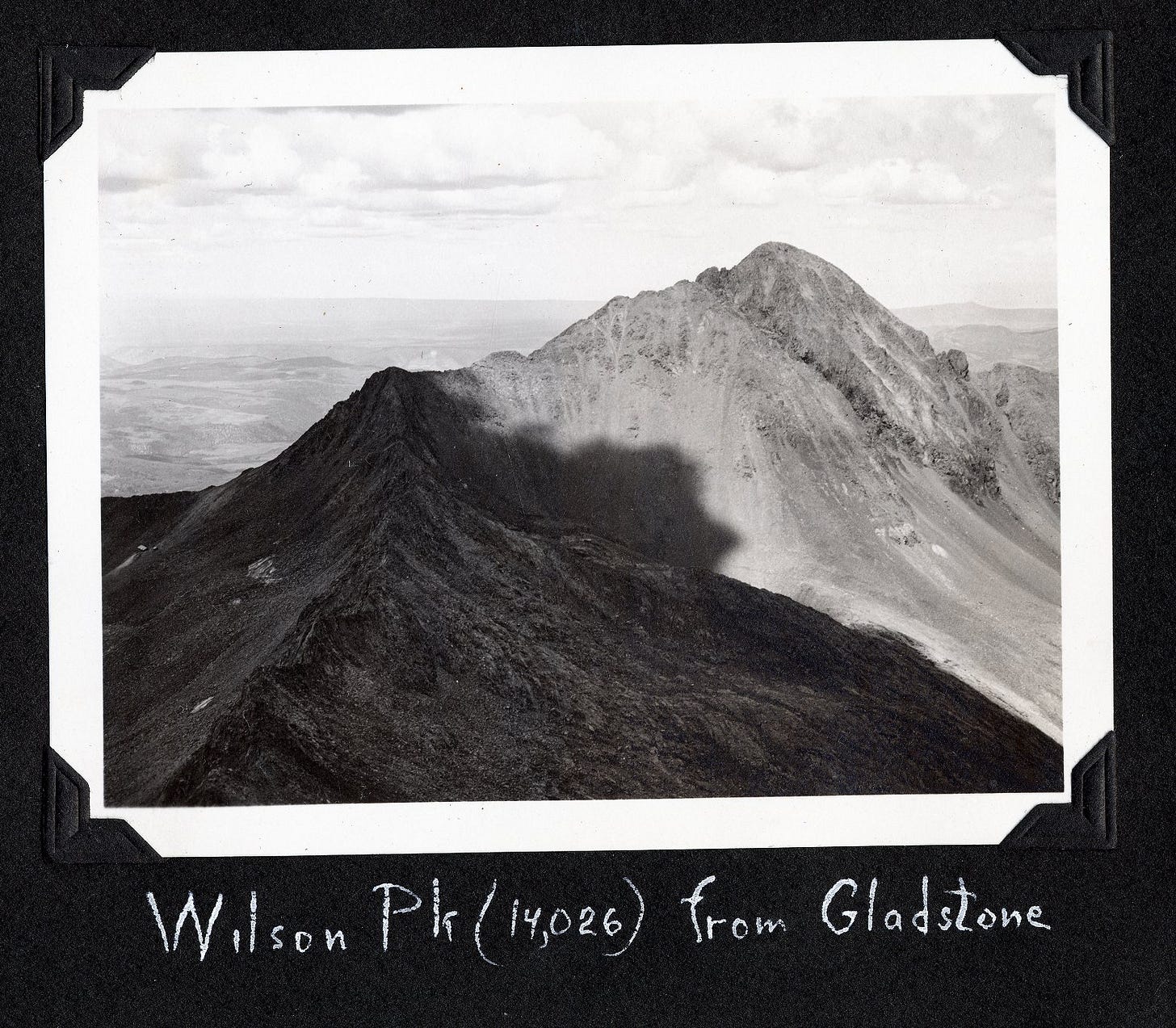How I Finally Climbed the King of the San Juan Mountains
Some perspectives on being a rookie and on the 14er fixation
If you’re new here and like what you read, please sign up for a free subscription to these hump-day posts. Support the site and gain access to bonus content and online meetups with a paid subscription.
Wind blasted my body, numbing hands and feet, as I ascended hand over hand toward the summit of Wilson Peak last Sunday. I had made a rookie mistake of dressing in too few layers, even though I knew it would be cold at 14,000 feet. Early-season snow coated the ledges of rock, making footholds slippery. If I looked down, I would see how far I could fall. I could bounce down hundreds of feet, like one of the rocks I had grabbed for support that came loose in my hand and plummeted.
I moved painfully slowly because I felt frozen from cold, nerves, and self-doubt. But at least I knew I wouldn’t fall, because a rope attached to my harness, and a guide had anchored the rope around a big solid rock a hundred or so feet above.
Yes, I used a rope and a guide. The helpful guide had bundled me up in a loaner jacket and adjusted the helmet on my head as if I were a little kid. My need for his help added humiliation to the mix of negative emotions creating tension and impeding my progress on this rock, as if I were summiting with training wheels.

I looked with envy at a woman way up above on the summit, who moved with such agility unsupported. I had overheard her say that this was one of her final 14ers to summit on the list of 53 (or 58, depending on how you count). To her, this was no big deal. To most locals, and to many of the accomplished female mountain runners whom I know and follow, this would be no big deal.
But to me, whenever I transition from hiking to climbing and the trail becomes a vertical series of obstacles with exposure, necessitating the use of my hands and triggering my fear of heights, it’s a big fucking scary deal. My confidence evaporates like sweat in dry mountain air. And I don’t like it. Shouldn’t I be better at this, given how much time I spend in the mountains and how fit I am?
Inch by inch, I made my way upward and finally, the summit widened and flattened. I could stand and step forward without using my hands. I could join my husband Morgan, who made it up much quicker and easier than I. Hallelujah!

We looked north to the undulating green mesa flanked by reddish canyon walls carved by the San Miguel and Deep Creek rivers. There’s our home over there. This view was a main reason for our outing up Wilson—to see where we live from this perspective.


We got out my iPhone and called my brother, who lives across the road from us in the cabin Dad built. The cabin’s deck faces Wilson Peak, and from the deck’s vantage point, the mountain’s shape rises like a figure with outstretched arms that beckon one toward it. My brother had set up his telescope for this moment. “Is that you in red?” he asked. He could see us, ant-sized!
All my life, I had gazed from the cabin to the summit. I had driven, run, hiked, and rode horses around the base of the mountain, viewing the summit from different angles. Finally, I could see this tippy-top point up close while standing on it. I could make sense of how the neighboring peaks—Gladstone, Mt. Wilson, El Diente—lined up and tucked in behind Wilson Peak. I could finally say that I had passed this locals’ rite of passage.
Morgan and I took our time to absorb the details of the panoramic view and count our blessings for being at this place on Earth, and then we followed the guide Ryan back down the way we came up.
Along the way, something surprising happened. I hiked, scooched, and climbed with less tension and greater fluidity. I talked and laughed because I felt relaxed. On the trickiest parts of the route, I made my way with less assistance and greater confidence.
The day prior, I had run up and over Ophir Pass—a rocky high-clearance mining road that tops out above tree line—and drivers in Jeeps had seemed impressed by my movement and made admiring comments like, “You go girl!” A few years ago, I had given a trail-running clinic on Ophir Pass, showing other women how to use trekking poles and run downhill over the rocky terrain. I had been the guide, they had been the rookies. They learned and got better. Now, I was in their shoes as the learner.
It hit me on the way down: There should be no shame in being a safety-conscious rookie who asks for help. That’s how you learn and get better. Without a guide, I would have struggled to find the route and get up the crux. I might have slipped and fallen, or given up halfway. I would have missed out on hearing all the helpful tips from the guide.
I stopped comparing and criticizing myself and felt a modicum of pride.
Wilson Peak is only the third 14er I’ve summited, the other two being Handies—considered Colorado’s easiest—and Sneffels, which is easier than Wilson Peak but features a tricky notch to climb at the top. Sneffels is “easy Class 3” and Wilson Peak is one of the harder Class 3s (see ranking of difficulty here).
Unlike many people who strive to summit each one, I am not driven to do many more just because they’re 14ers. The 14er craze has led to numerous deaths, especially on Capitol Peak, and has created overcrowding on trails to the more popular 14ers in the central part of the state. (Check out the newsletter Cole’s Climb for worthwhile coverage about 14ers.)
I went up Handies because it’s part of the Hardrock course. I went up Sneffels inspired by the family history wrapped up in the Sneffels range, trying to imagine what it must have been like for my grandmother to ascend it in 1932 (story here).
Similarly, I went up Wilson Peak because it feels special, not because it measures 14,021 feet, and not because it’s the stylized image on the Coors can. And I’m definitely not driven to check off all the summits on the 14er list.
Our family nicknamed Wilson Peak “The King” and Sunshine Peak next to it “The Queen” because of how they sit side by side and look like thrones for royal figures. To say Wilson Peak looms large in my psyche is an understatement. Morgan and I intended and planned for years to get up it, rescheduling numerous times due to bad weather, and finally we did it.
Also, like Sneffels, I went up Wilson Peak inspired by my grandfather’s brother Dwight Lavender, who explored and mapped the Wilson range from 1928 through the early ‘30s, even naming El Diente (“the tooth”). The more I learn about what Dwight and other founding San Juan Mountaineers did, the more I am in awe of them. With my little bit of novice mountaineering, I try to pay homage to them and strive to be a little more like them.


My point is, we should climb mountains if they tug at our heart, not necessarily because of how high they measure or for the bragging rights that go with it. I recall fondly how we kicked off summer by summiting Courthouse Mountain, because I always gazed at it while driving by and felt drawn to its blocky high point. It’s “only” 12,152 feet, but that doesn’t make it less worthwhile to me.
I get that some people feel motivated to complete a list of summits, similar to how birdwatchers obsessively travel to spot and log additional species. That’s fine, as long as it doesn’t lead to irresponsible, unprepared summit attempts. It’s just not my thing. I am a runner, not a peak-bagger.
And yet, I’d like to go back to the Wilson range and sit atop a different spot for a different vantage point. The 13er Dolores Peak appeals to me, so I can get a side view of the Wilsons.
The 14ers El Diente and Mt. Wilson still scare me, and that’s OK. It means if I approach them, I’ll do it with the utmost safety and respect. And probably a guide, too.
Many thanks to Telluride Mountain Guides and guide Ryan Howe. For peak-bagging inspiration, check out this profile I wrote for iRunFar about Whiley Hall, who’s summiting all 13ers in the state. For an excellent, beautiful book about the 14ers, see Colorado’s Highest: The History of Naming the 14,000-Foot Peaks by Jerry Norgren with photos by John Fielder. To help protect the 14ers from degradation, become a supporter of the Colorado Fourteeners Initiative.
Related posts:
Digging Into the San Juan Mountains — learn about San Juan Mountain pioneers such as A.D. Wilson, for whom both Wilson Peak and Mt. Wilson were named
Learning the Ropes at the Ouray Ice Park — a foray into winter climbing







Thanks for the shout out! Never feel bad about doing things the safe way. For what it's worth, I recently interviewed Jeremy Ashcroft, a UK climber and illustrator. He says a lot of European climbers look at Coloradans like absolute lunatics for climbing some of these spots unroped.
I also love your sentiment about climbing because it calls to you, not to fulfill someone else's checklist. Amen!
See there, no Walter Mitty moments for you, all for real for real. Good going. So, here is my trivial question, are you doing this in Stinson's? No judgement, promise ...lately I have been fast packing in Mafates and enjoying the float. Since I have been moonlighting at REI and have access to beta waaaay too many shoes I am always staring at feet. Which makes me sound...yeah., anyway I wondered if you feel nimble in a stack height associated with a maximal cushion Hoka model. And did you bring a set of Kahtoola or other brand of easily doffed/donned traction devices? These epic stories from Colorado are rad btw. Two weeks ago I topped out in Virginia and bagged our highest peak, Mt Rogers..ahem, around 5000 feet. Whoop whoop, not worthy of a King Kong chest thumping, regrettably. Does anyone say rad anymore?...oops, getting older. Thanks for the narrative per usual.